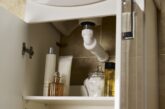
Professional Builder’s Edward Kelly takes a look at DosaFil Residential Technologies, a solid new entrant to the central heating market

The way that we treat boilers and heating systems isn’t something we often think about. In fact, the process of pouring an inhibitor to keep a central heating system running efficiently hasn’t really changed all that much in the last sixty years or so. Bear that in mind and you’ll realise why the arrival of DosaFil Residential Technologies is a big one and may drastically change the way we treat heating systems for the foreseeable future.
The DosaFil brand began in the commercial heating/cooling sectors, making water conditioning devices. The aim here was to provide an eco-friendlier, safety conscious and less energy consuming alternative. It was from here that the company began to pair solid chemicals with these devices, working as a more concentrated version of the usual liquid treatment products. (Think dishwasher tablets!) With the success of these solid solutions, the next natural step was the residential market and so, DosaFil Residential Technologies was born!
The range
So, what are these solid chemicals that the company has brought to market? The range consists of four different products, all with different functions. Thankfully, they’re also all pretty self-explanatory.

The DR1 Inhibitor for example is, well, an inhibitor. It’s to help keep your boiler running efficiently and will help prevent corrosion in the central system and stop sludge from building up. While engineers will usually agree that this should be topped up once a year, most testing kits to see whether a system needs its inhibitor topping up will simply say yes or no, not how much product is required. Because of that, usual practice is to just dump a whole bottle of inhibitor into the system.

Where DosaFil’s inhibitor changes this is that its testing kit gives an indication of how much of the product is required (each pack is split into three separate solid sticks). That way, you may only need one stick for one service and can still keep the other two for the next appointment that needs it. The NSF CIAS accredited product (an achievement in and of itself) is dosed via a filter with each stick individually wrapped in a dissolvable wrap. This is the case for the whole range and means there’s no actual contact with the chemicals themselves.
The DR2 and DR3 cleaners are for new systems and those needing more heavy duty cleaning respectively. The former dissolves in hot water in just 15 minutes where the latter is designed to mobilise sludge in those older systems.

The DR4 is a biocide, designed for low temperature central heating systems, such as heat pumps and underfloor heating. Because of the lower temperature nature of these systems, bacteria and all manner of nasty things are able to grow and aren’t killed off as they would be in a more traditional system. Dosing this solid biocide will get rid of anything in there and won’t need to be done again – unless a system is drained, and new water introduced.

Ease of use
Founder and Managing Director of the company, Steve Crick is certainly embodying his father’s ethos that he shared with us on a press day: There has to be a better way. Speaking on DosaFil Residential Technologies, he said “We set out to challenge the status quo, creating a safe, easy to install and operate water conditioning system that also addresses common key concerns of modern business, such as health and safety, eco friendliness and reduction of energy consumption”.
The range of solid products on offer across the country have gone down a storm with installers, with the company’s market research boasting very positive responses. Ease of use is naturally one major attraction. There’s no spillage or mess with the solid products and, importantly, the tiny boxes take up a fraction of the room a comparable 1L plastic jerry can would. While a 1L plastic bottle might not sound like a lot of space, when that’s scaled up to account for multiple services that little space will get bigger and bigger. Weight is a huge difference too, with a liquid inhibitor weight of around 1.16KG compared to a DosaFil solid of 0.098KG.
Sustainability
This brings us on to sustainability. The size and weight difference between DosaFil’s range and more conventional liquid treatments doesn’t just mean less space in the back of an installer’s van. A pallet with the company’s most popular options, the DR1 Inhibitor and DR3 Heavy Duty Cleaner will reportedly fit 3.5x as many products compared to the closest liquid competitor, meaning there’s 3.5x less carbon in distribution.
This is coupled with the plastic free nature of the products. Apparently, two or three plastic bottles are sent to landfill for every boiler or heat pump installed (the plastic can’t be recycled once they’ve had these chemicals touching them), amounting to an eye watering 3+ million bottles a year. Using cardboard looks to stop this and has a huge reduction in the amount of C02 emitted in producing the packaging of the product too. In fact, DosaFil attests that there’s just 7.52g of embodied carbon per DR1 box, compared to 360g for a 1L plastic jerry can.
I suppose the important question is though, why should we care about that? Well, “going green” is becoming increasingly important, particularly in our industry with an approaching Future Homes Standard and Net Zero aspirations. Customers are appreciating sustainable practices more and more too, if industry surveys are anything to go by. We are undeniably in a climate crisis, (just look at the bizarre weather outside!) and so conscious choices like these are a no brainer – especially when they’ll probably make life a lot easier. Building a Solid Future indeed!
For further information on Dosafil visit DosaFil Residential Technologies – DosaFil® Water Conditioning.







